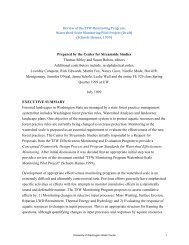Copyright 2012 Aileen M. Echiverri-Cohen - University of Washington
Copyright 2012 Aileen M. Echiverri-Cohen - University of Washington
Copyright 2012 Aileen M. Echiverri-Cohen - University of Washington
You also want an ePaper? Increase the reach of your titles
YUMPU automatically turns print PDFs into web optimized ePapers that Google loves.
For the third hypothesis <strong>of</strong> estimating predictors <strong>of</strong> trauma-related outcomes, with a<br />
maximum <strong>of</strong> five predictor variables (L1, L2, L3, L4, L5), a sample <strong>of</strong> 49 participants provided a<br />
minimum 80% power to detect a large effect (<strong>Cohen</strong>'s d = 0.8).<br />
effects.<br />
Main Analyses<br />
Thus, power was adequate across main analyses to detect large, clinically relevant<br />
Random Effects Modeling. Random effects modeling is a widely-accepted data analytic<br />
technique in longitudinal research designs because it affords modeling individual change and<br />
variances (Tasca & Gallop, 2009). This approach allows for examination <strong>of</strong> both within-subject<br />
(level 1) and between-subject (level 2) factors in a participant’s response. The combination <strong>of</strong> the<br />
level 1 and level 2 factors is translated into a mixed linear model with fixed and random<br />
coefficients with person-specific parameters corresponding to a random intercept and a random<br />
slope. Random effects modeling is appropriate for data that have a nested or hierarchical<br />
structure by modeling the within-subject correlation using random effects, and missing data that<br />
are inherent in longitudinal treatment data (Gibbons et al., 1993). Random effects modeling is<br />
superior to other data analytic techniques that are typically used in repeated measurement studies.<br />
Unlike analysis <strong>of</strong> variance techniques that violate the assumption <strong>of</strong> sphericity (i.e., equivalent<br />
error variances and correlations between two measurements across time) resulting in inflated<br />
Type 1 error rates, ignore within subject correlation for hierarchical data resulting in<br />
understestimating the variance in the model, and rely on group averages and group variance,<br />
random effects modeling does not (Tasca & Gallop, 2009).<br />
30
















